Motorcycle accidents continue to be a significant concern on roads across the United States. Despite motorcycles constituting 3% of registered vehicles and only .7% of miles traveled domestically, motorcyclists are disproportionately represented in traffic fatalities and injuries. In 2022, motorcyclists accounted for 14.6% of all traffic fatalities and 3.5% of all injuries [1]. The vulnerability of motorcyclists makes them 28 times more likely to die in a crash and four times more likely to be injured due to less stability, restricted visibility, and less protection than enclosed vehicles.
In 2024, the statistics surrounding motorcycle accidents highlight the ongoing dangers faced by riders. Factors such as high-performance capabilities, exposure to weather and road conditions, and the physical and mental demands of riding contribute to the elevated risks. Federal data reveals that motorcyclists’ death rates per mile traveled are nearly 24 times higher than those of car occupants. This guide aims to provide a detailed analysis of the latest statistics on motorcycle accident fatalities and injuries and explore the causes, impacts, and preventive measures to enhance safety for motorcyclists.
If you have been injured, call us today at (866) 936 7349 to schedule a free consultation
Motorcycle Death Statistics
The provided data from the National Safety Council (NSC) and the National Highway Traffic Safety Administration (NHTSA) illustrates a detailed year-by-year account of motorcycle fatalities and death rates. Motorcycle deaths have seen significant fluctuations over the years with recent data highlighting both concerning trends and areas of improvement.
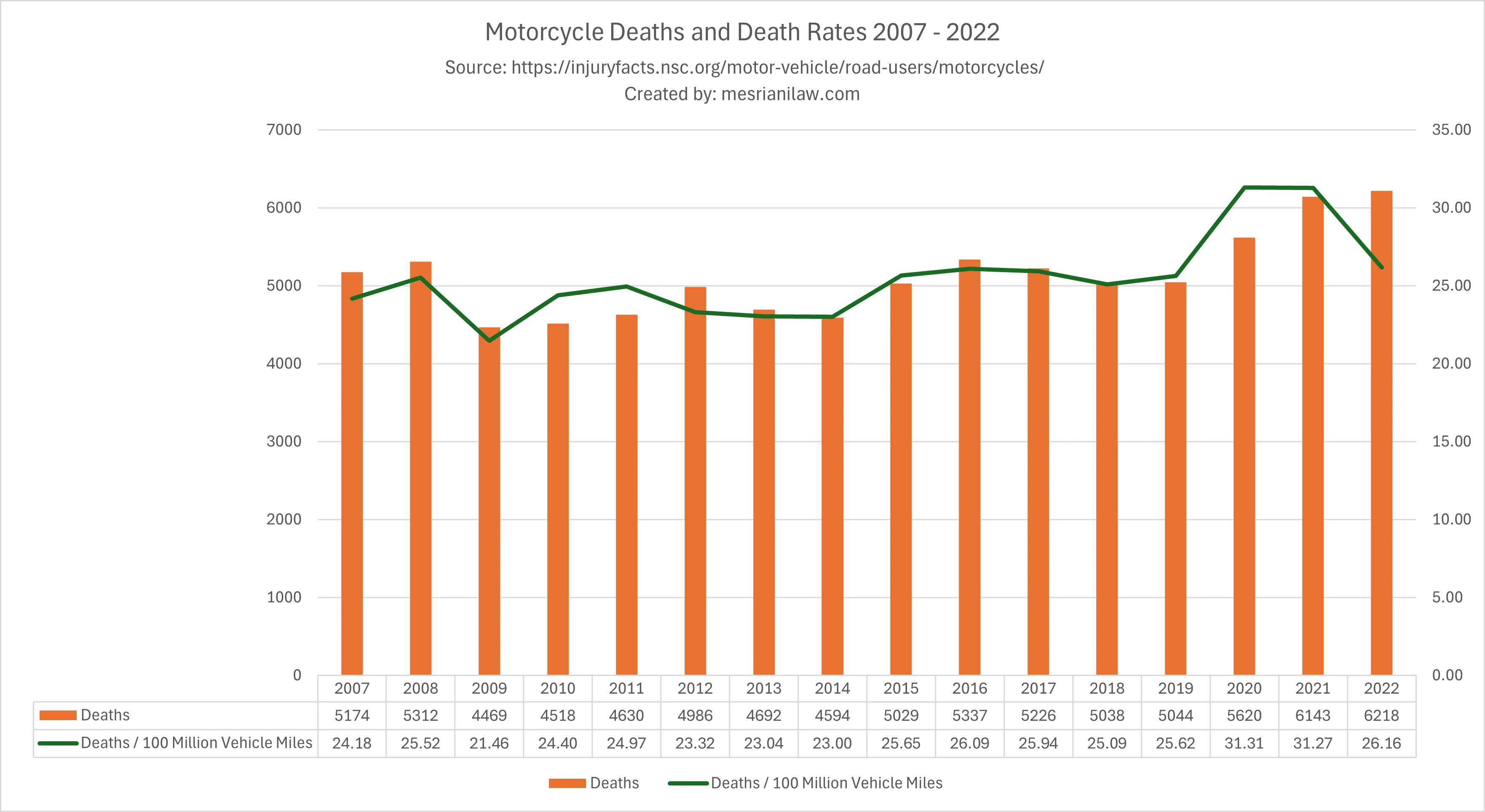
- In 2022, the number of motorcycle fatalities reached an all-time high of 6,218 deaths which reflects a 1% increase from the previous year.
- Despite this rise in fatalities, the death rate per 100 million vehicle miles traveled in 2022 saw a notable decrease of 16% when compared to 2021. This was attributed to a 21% increase in miles driven by motorcyclists.
- Since 2012, the overall number of deaths among motorcycle riders and passengers has surged by roughly 25%, while the death rates have increased by 12%.
- The death rate per 100 million vehicle miles traveled was at its highest in 2020 with a rate of 31.31 which coincided with 5,620 fatalities. This was a 29% increase when compared to the lower rate of 24.18 in 2007 when the study started.
By being able to monitor trending motorcycle fatality data, we can determine if safety programs are effectively reducing motorcycle accident related deaths.
California Motorcycle Accident Fatality Statistics
When comparing national and California motorcycle accident fatalities metrics [2], the data indicates that the national trend appears to be closely aligned with California’s with swings in either direction occurring mostly in tandem.
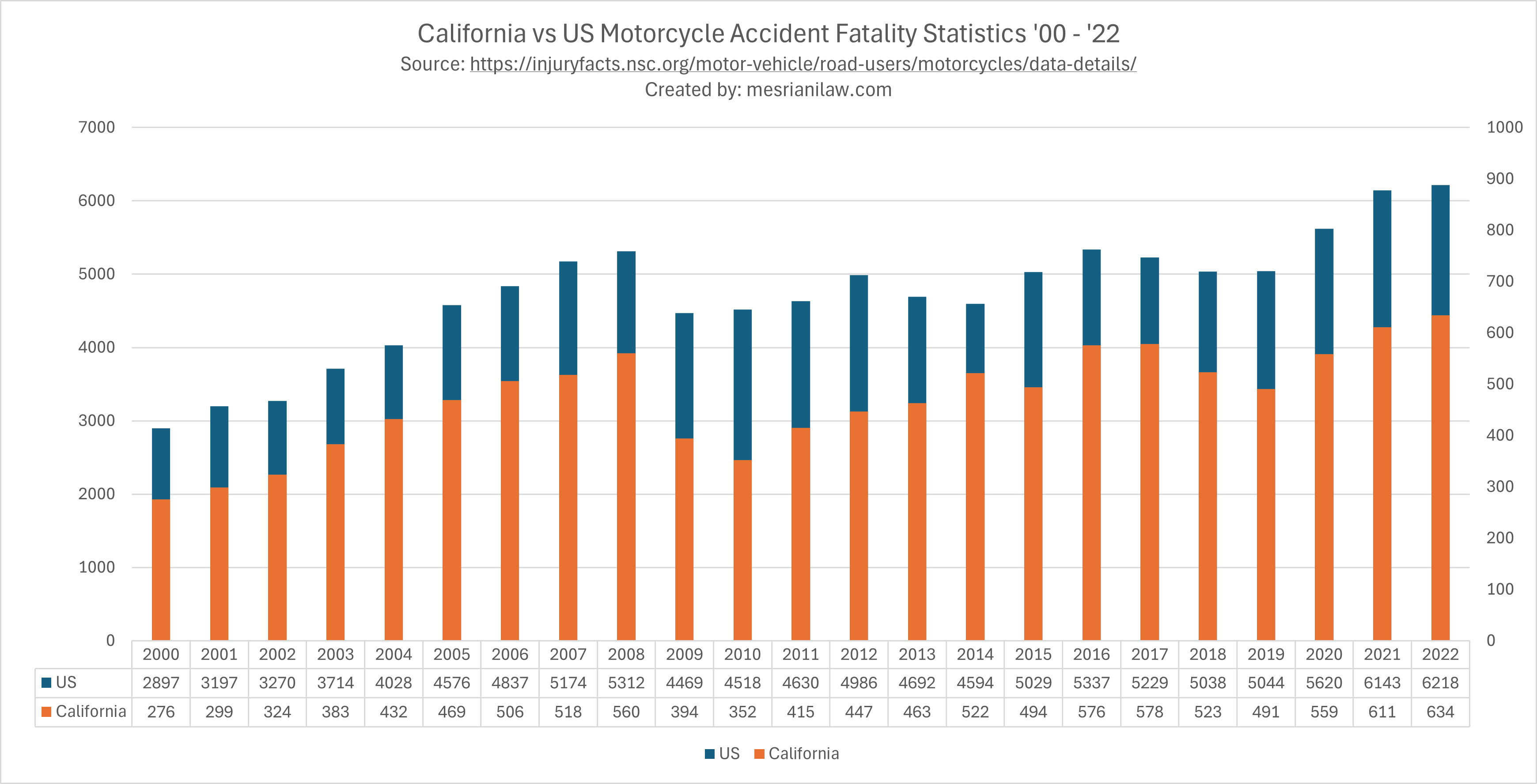
- Both national and California trends witnessed a noticeable increase in motorcycle accident fatalities in recent years with an upward trend that emerged in 2019.
- In 2022, California reported 634 motorcycle accident fatalities which was an all-time high since the start of the study in the year 2000.
- The study indicated a 130% increase in motorcycle accident fatalities since the year 2000 and a 4% year over year increase when comparing motorcycle accident fatalities in 2022 to 2021.
These numbers highlight the on-going need for enhanced safety measures, awareness campaigns, and stricter enforcement of traffic regulations to protect motorcyclists and reduce the number of fatal accidents on California’s roads. It is interesting to note that while CA reports an estimated 12% of America’s total population [3], the motorcycle accident fatalities only account for 9-10% of national numbers. This likely indicates that California’s stricter motorcycle safety laws and helmet requirements are somewhat effective in reducing motorcycle accident fatalities.
If you have been injured, call us today at (866) 936 7349 to schedule a free consultation
Causes of Motorcycle Accident Fatalities
Understanding the causes of motorcycle accident fatalities is crucial in developing effective strategies to reduce these tragic incidents. According to the University of California, Berkeley, several key factors [4] contributed to motorcycle collisions resulting in serious injuries and fatalities in 2020:
- Speeding: 30.9%
- Improper turning: 22.2%
- Automobiles failing to yield the right-of-way: 16.1%
- Impairment by alcohol or drugs (either the motorcyclist or the driver): 8.9%
- Failing to obey traffic lights or stop signs: 4.4%
Motorcycle Accident Fatalities Caused by Speeding
Speeding is the most likely contributing factor in motorcycle accident fatalities, with 34% of all fatal motorcycle accidents involving excessive speed. This alarming statistic translates to nearly one in three motorcyclist deaths were influenced by driving too fast [5]. Speeding not only increases the risk of collisions due to extended stopping distances and reduced control but also amplifies the severity of crashes when they occur. The crash energy and forces exponentially increase with higher speeds which leads to more catastrophic outcomes. Riders between the ages of 25 and 29 are particularly prone to speeding with 45% of fatalities in this age group involving speeding.
Motorcycle Accident Fatalities Caused by Improper Turning and Right of Way Disputes
Improper turning is the #2 factor that contributes to motorcycle accident fatalities. Data from 2017 indicates that there were 2,598 two-vehicle fatal crashes involving motorcycles and other vehicles, with 42% of these incidents occurring when other vehicles turned left in front of oncoming motorcycles [6]. This dangerous maneuver often leaves motorcyclists with little time to react which leads to severe collisions that often result in fatalities.
The National Transportation Safety Board (NTSB) has identified several high-risk traffic scenarios that result from improper turning. Motorcycles often fall on the roadway while attempting to avoid collisions which accounts for a significant number of crashes. Sideswipe accidents, typically resulting from drivers failing to check blind spots before changing lanes, are also frequent. These findings suggest that many motorcycle fatalities caused by improper turning could be prevented if other drivers were more vigilant and better anticipated the presence of motorcycles when making turns or changing lanes.
Motorcycle Accident Fatalities Caused by Alcohol Use
Alcohol impairment is another major contributor to motorcycle accident fatalities that significantly increases the risk and severity of crashes. In 2021, 29% of fatally injured motorcycle drivers had a blood alcohol concentration (BAC) at or above 0.08% [7] which is the legal limit in most states. This percentage is even higher in single-vehicle crashes, where 43% of the fatalities involved an alcohol-impaired driver. The risk of fatal crashes that involve alcohol rises substantially during nighttime hours, with 49% of motorcycle drivers killed between 9 p.m. and 6 a.m. having a BAC at or above 0.08%.
The dangers of alcohol impairment can begin even at lower BAC levels. In 2020, 27% of 5,268 motorcycle fatalities involved riders who were driving under the influence. While a BAC of 0.08% is the legal threshold for driving under the influence, significant impairment can still occur at lower levels. A BAC of just 0.02% can lead to poor decision-making and at 0.05%, drivers may experience blurred vision [8]. When accounting for riders with BACs between 0.01% and 0.07% those 1,422 fatalities climbed to 1,737 [9]. These statistics show the importance of avoiding alcohol consumption when riding and promoting safe driving practices to reduce motorcycle fatalities caused by alcohol use.
Motorcycle Accident Fatalities Caused by Lane Splitting
Motorcycle accident fatalities caused by lane splitting represent a significant safety concern. Lane splitting, the practice of motorcyclists riding between lanes of traffic, has been controversial due to its associated risks and benefits. While lane splitting can potentially reduce traffic congestion and provide motorcyclists with greater mobility, it also places riders in close proximity to other vehicles, which can increase the likelihood of accidents, especially fatal ones.
Research conducted by the University of California, Berkeley [10], highlights the complex relationship between lane splitting and motorcycle safety. The study found that lane-splitting motorcyclists who adhered to specific safety guidelines like maintaining a speed differential of 15 mph or less and performing the maneuver in traffic moving at 50 mph or less were significantly less likely to suffer severe or fatal injuries. These benchmarks helped the state of California establish the recommended speeds for lane splitting which are:
- 30 mph top speed of traffic flow
- 10 mph speed differential between vehicles being passed
When motorcyclists engaged in lane splitting at higher speeds or with greater speed differentials, the risk of fatal accidents increased. These findings suggest that while lane splitting can be a relatively safe practice under certain conditions, it becomes hazardous when performed recklessly.
If you have been injured, call us today at (866) 936 7349 to schedule a free consultation
Factors That Impacted Motorcycle Accident Fatalities
Several critical factors have impacted motorcycle accident fatalities in recent years. These include helmet use, licensing status of the riders, the time and location of accidents, and demographic variables such as age and gender. Understanding these factors can help in developing targeted strategies to reduce fatalities and enhance motorcycle safety.
Motorcycle Accident Fatalities and Helmet Use
Motorcycle accident fatalities are significantly influenced by helmet use. Helmets are a critical safety measure that can drastically reduce the severity of head injuries in the event of a crash by providing a layer of protection that absorbs the shock of impact. Statistics from the National Highway Traffic Safety Administration (NHTSA) reveal that wearing helmets has saved over 25,000 lives between 2002 and 2017 [11]. Motorcycle helmets are estimated to be 37% effective in preventing fatal injuries for motorcycle operators and 41% effective for passengers. The observed use of Department of Transportation compliant helmets is significantly higher in states with universal helmet laws, which also report lower fatalities. Despite this, there is a concerning trend has emerged where helmet use has slightly declined since 2018 [12]. It is crucial for riders to understand that wearing a U.S. DOT compliant helmet can make them three times more likely to survive a head injury compared to those not wearing a compliant helmet.
Licensed Motorcycle Drivers
In 2021, 36% of riders involved in fatal motorcycle crashes were riding a motorcycle without a valid motorcycle license. This shows the importance of proper licensing and the potential risks associated with riding without adequate training and legal authorization. The data reveals that motorcycle riders involved in fatal crashes also often had previous driving infractions. They were 1.2 times more likely to have prior license suspensions or revocations compared to passenger car drivers [13]. This trend indicates a correlation between a history of traffic violations and the likelihood of being involved in fatal accidents. It emphasizes the need for stringent enforcement of licensing laws and continuous education for motorcyclists to enhance road safety and reduce fatalities.
Time of Motorcycle Accident
In 2022, the timing and location of motorcycle accidents reveal significant patterns. 60% of motorcyclist fatalities happen between May and September, with June experiencing the highest number of deaths and January the lowest. This seasonal peak correlates with increased riding activity during warmer months. Additionally, 46% of motorcycle fatalities happened on the weekend [14] with motorcyclist fatalities being more likely to happen after 3 p.m. on weekends. These times indicate that extra care should be taken when taking summer weekend drives in the evening.
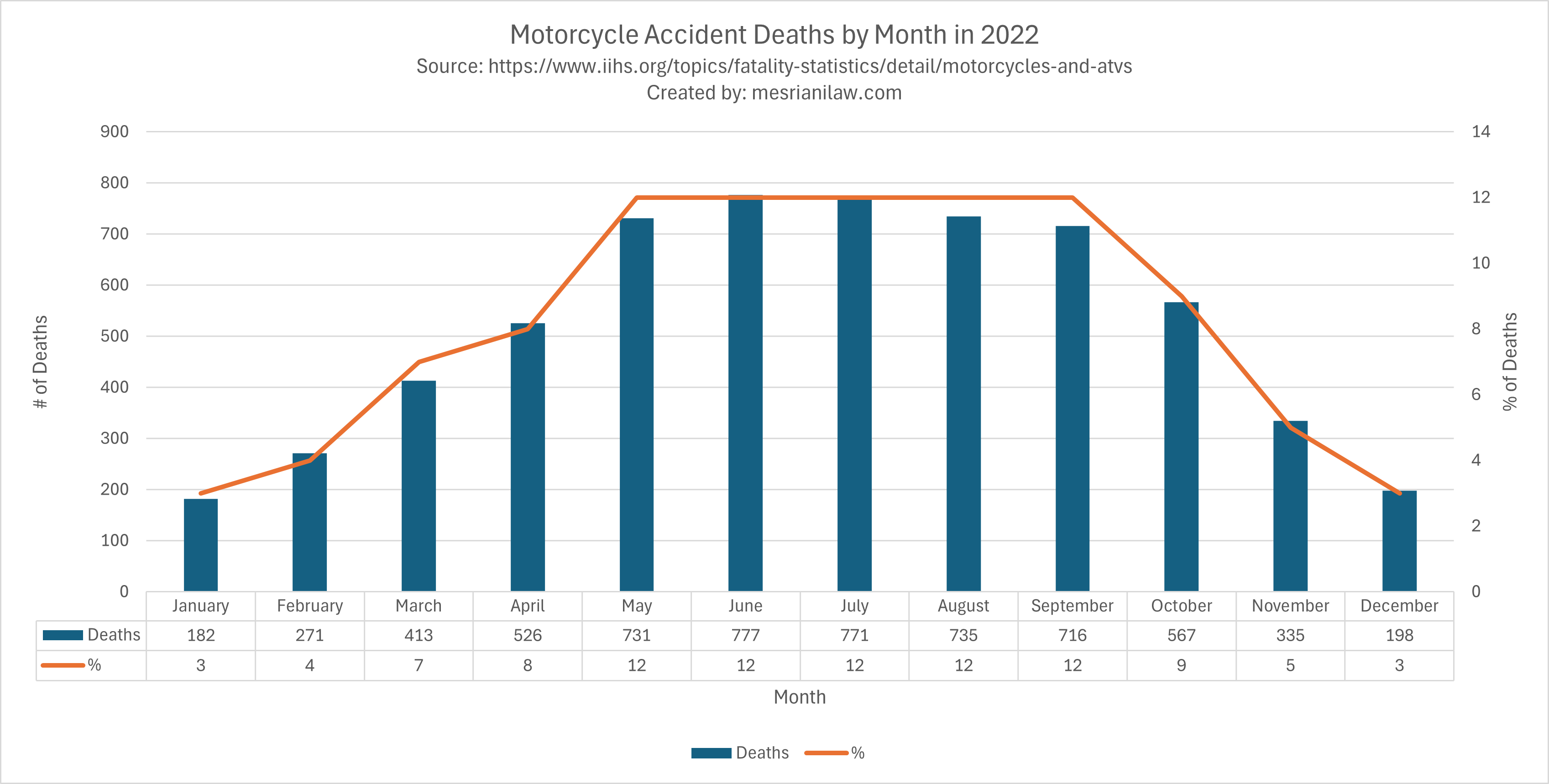
Location of Motorcycle Accidents
The location of motorcycle accidents plays a significant role in the likelihood of fatalities. Intersections are particularly hazardous, with 34% of 2019 motorcycle fatalities [15] occurring at these junctures. The complex traffic patterns and the convergence of multiple vehicles sometimes makes intersections deadly for motorcyclists. Drivers may not see or misjudge the speed of approaching motorcycles which can result in collisions.
Urban areas are notably more dangerous for motorcyclists compared to rural or suburban locations. Approximately 67.42% of motorcycle fatalities happen in urban settings, where traffic is denser, and streets are more congested. In contrast, only 32.58% of fatalities occur on rural roads [16]. Furthermore, the majority of these accidents do not happen on interstates, which are relatively safer for motorcyclists. Instead, 54% of motorcyclist deaths in 2021 occurred on major non-interstate roads. These statistics highlight the importance of increased awareness and safety measures in urban areas and intersections to protect motorcyclists from fatal accidents.
Demographic of Motorcycle Riders
Motorcycle accidents and fatalities exhibit distinct demographic patterns that highlight the risks faced by certain groups. In 2020, there were 5,506 motorcyclists killed in traffic crashes, with a significant portion being young and middle-aged males. White motorcyclists accounted for 60% of these fatalities, followed by Hispanic or Latino (14%) and Black or African American (11%) riders [17]. This distribution shows the higher prevalence of motorcycle use and related fatalities among white riders compared to other racial and ethnic groups which can help with targeted advertising to help distribute cautionary messaging.
Male riders, particularly those aged 25-34, represented the largest demographic group involved in motorcycle fatalities, making up 25% of all riders killed [18]. Additionally, motorcyclists aged 44-69 also saw considerable numbers, with an increasing number of women starting to show up in the data at this age group. Female statistics are likely being bolstered by passenger fatalities as 57% of women who died in motorcycle accidents were not driving [19]. This data suggests targeted safety interventions and educational campaigns could be particularly beneficial for young and middle-aged male riders to mitigate the high incidence of fatalities in these groups.

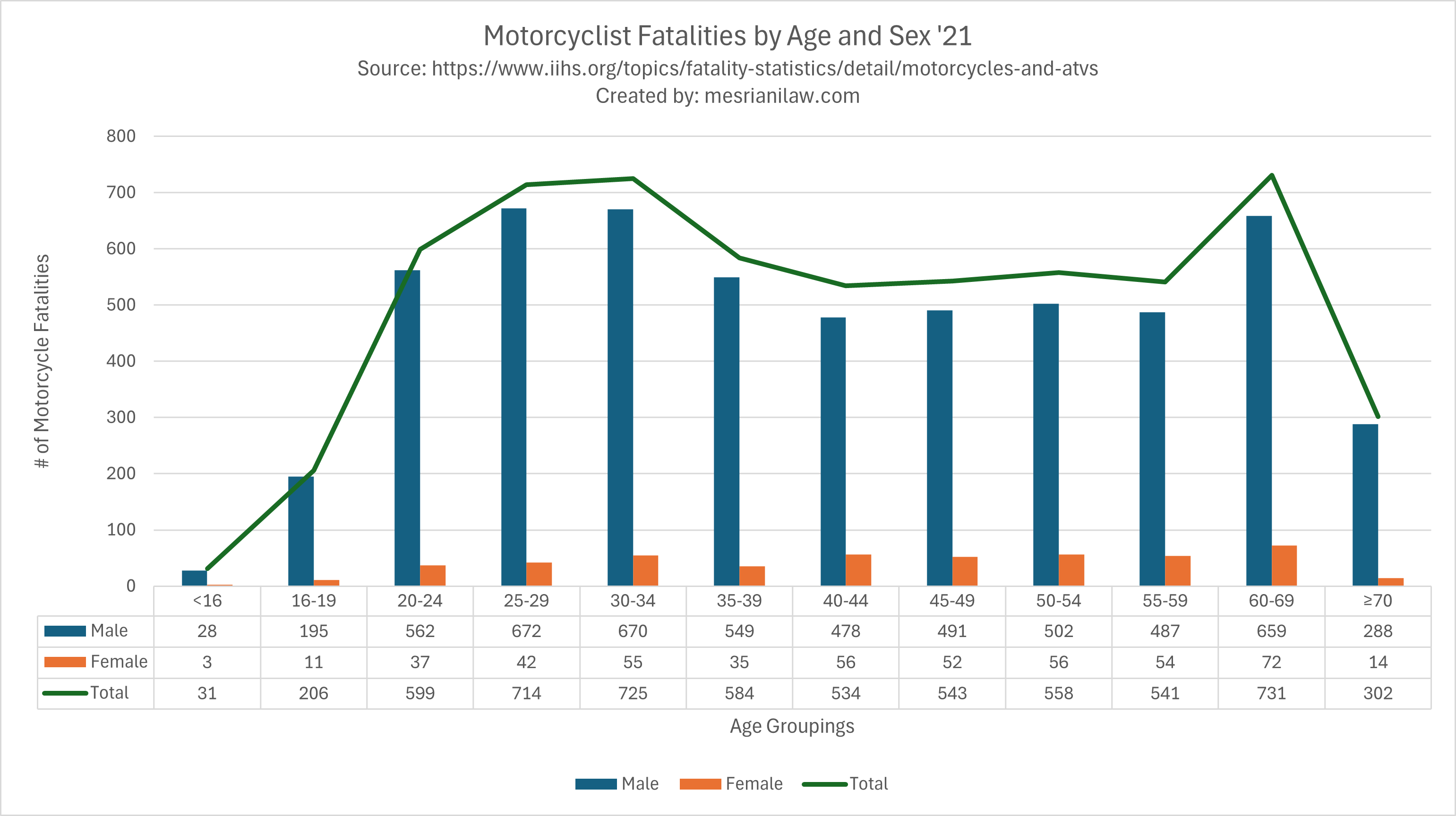
Engine Size of Motorcycle
The engine size of motorcycles involved in fatal crashes has seen a significant increase over the years. In 2021, 34% of motorcyclists killed were riding motorcycles with engine sizes larger than 1,400 cc which is a stark rise compared to 9% in 2000 and less than 1% in 1990 [20]. This shift indicates a growing preference for more powerful motorcycles, which unfortunately correlates with a higher risk of fatal accidents due to the greater speeds and forces involved in crashes.
Crash Type
Motorcycle crash deaths can also vary significantly based on the type of crash involved. In 2022, 37% of motorcyclist deaths occurred in single-vehicle crashes, while the remaining 63% were the result of multiple-vehicle crashes [21]. This distribution highlights the unique risks motorcyclists face, both from losing control on their own and from interactions with other vehicles on the road. The trend over the years indicates that multiple-vehicle crashes consistently account for a higher proportion of motorcycle fatalities with that rate increasing steadily over the past decade.
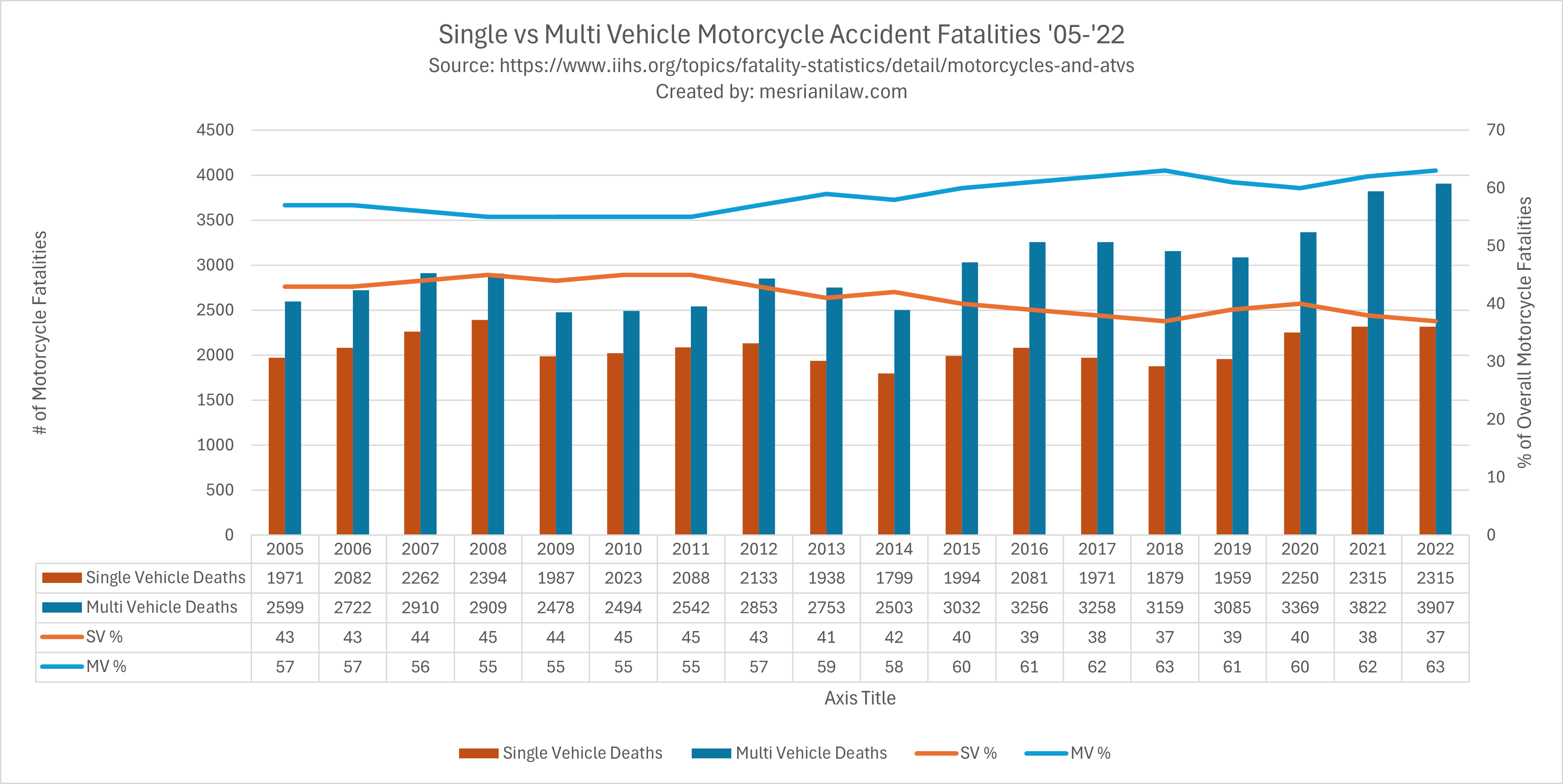
If you have been injured, call us today at (866) 936 7349 to schedule a free consultation
Motorcycle Accident Injury Statistics
The number of nonfatal motorcycle injuries saw a slight increase of 2.6% from 2021 to 2022. However, the injury rate per 100 million vehicle miles traveled decreased by 19% during the same period [22]. This decline in the injury rate indicates that while the absolute number of injuries rose slightly, the frequency of injuries relative to the amount of travel decreased. This trend suggests safety programs have been effective in reducing the rate at which motorcycle accidents occur, even as more miles are being traveled by motorcyclists.
Motorcycle Usage Statistics
Motorcycle usage trends have shown mixed patterns in recent years.
- In 2022, while the number of registered motorcycles decreased by 2%, there was a significant 21% increase in the number of miles traveled via motorcycle.
- The increase in miles driven resulted in a notable 16% decrease in the fatality rate per 100 million vehicle miles traveled and a 19% decrease in the injury rate, despite relatively stable numbers of fatalities and injuries.
- Over the last decade, the number of registered motorcycles has grown by 14%, and the number of miles driven has increased by 17%.
The data from 2007 to 2022 shows that the highest number of registered motorcycles was recorded in 2021, with 9,795,491 motorcycles, while the highest mileage driven was in 2022, with 23,765 million miles traveled. These trends reflect an increased use of motorcycles which could be driven by rising fuel costs and a preference for more economical and agile modes of transportation.
Critical Takeaways from Motorcycle Accident Fatality and Injury Statistic Data
The analysis of motorcycle accident fatality and injury statistics provides valuable insights into the factors contributing to these tragic events and highlights effective measures to enhance rider safety. Here are the key takeaways:
- Helmet Use is Crucial: Helmets significantly reduce the risk of fatal head injuries. DOT-compliant helmets offer the best protection, and all riders and passengers should wear helmets for every ride.
- High-Risk Demographics: Young riders, particularly those aged 25-34 and older riders aged 50 and above, have higher fatality rates. Tailored safety interventions are needed for these age groups.
- Alcohol and Speeding: A substantial percentage of motorcycle fatalities are associated with alcohol impairment and speeding. Riders should avoid riding under the influence and adhere to speed limits to reduce the risk of accidents.
- Time and Location: Fatal motorcycle accidents are more likely to occur during weekend evenings and weekday commuting hours. Intersections and urban areas are also particularly dangerous for motorcyclists so extra vigilance is needed to avoid accidents at these junctures.
- Engine Size: Motorcycles with larger engine sizes (>1,400 cc) have become more common among fatal crash victims which highlights the need for riders of powerful bikes to exercise extra caution.
- Protective Gear and Visibility: Wearing protective gear such as jackets, pants, boots, and gloves can prevent severe injuries. Increasing visibility with high-visibility colors and retro-reflective materials can help other drivers see motorcyclists which can reduce the likelihood of collisions.
Safety Recommendations
- Regular Motorcycle Checks: Before riding, inspect your motorcycle for any mechanical issues to ensure that lights, tires, brakes, and fluids are in good working order.
- Avoid Impairments: Never ride after consuming alcohol or drugs that impair your abilities. Staying sober is essential for maintaining full control and awareness on the road.
- Adhere to Traffic Laws: Follow all traffic laws, including speed limits, and avoid reckless behaviors. Staying alert and anticipating potential hazards can prevent many accidents.
- Use Protective Gear: Always wear a DOT-approved helmet and other protective gear to minimize injury risks.
- Increase Visibility: Enhance your visibility to other motorists by wearing bright and reflective clothing, especially during night rides.
By adopting these practices and understanding the factors contributing to motorcycle accidents, riders can significantly improve their safety and reduce the likelihood of fatalities and serious injuries.
Contact Mesriani Law if You’ve Been Injured in a Motorcycle Accident
If you or a loved one has been injured in a motorcycle accident, it is crucial to seek professional legal assistance to protect your rights and secure the compensation you deserve. The experienced attorneys at Mesriani Law Group are dedicated to helping motorcycle accident victims navigate the complexities of their cases and achieve the best possible outcomes. Don’t face the aftermath of a motorcycle accident alone; contact Mesriani Law Group today to discuss your situation and get the expert guidance you need. Your path to recovery and justice starts with a simple call.
If you have been injured, call us today at (866) 936 7349 to schedule a free consultation
Sources
[1] [22] https://injuryfacts.nsc.org/motor-vehicle/road-users/motorcycles/ [2] https://injuryfacts.nsc.org/motor-vehicle/road-users/motorcycles/data-details/ [3] https://en.wikipedia.org/wiki/Demographics_of_California [4] https://safetrec.berkeley.edu/sites/default/files/publications/safetrecfactsmotorcyclesafety_2022.pdf [5] https://www.motorcyclesdata.com/2024/03/04/the-impact-of-speed-on-motorcycle-accidents-breaking-down-the-numbers/ [6] https://crashstats.nhtsa.dot.gov/Api/Public/ViewPublication/812785 [7] [14] [16] [19] [20] [21] https://www.iihs.org/topics/fatality-statistics/detail/motorcycles-and-atvs [8] https://alcohol.org/health-effects/blood-alcohol-concentration/ [9] https://www.moneygeek.com/insurance/motorcycle/analysis/accidents-and-deaths/ [10] https://www.ots.ca.gov/wp-content/uploads/sites/67/2019/06/Motorcycle-Lane-Splitting-and-Safety-2015.pdf [11] [12] https://injuryfacts.nsc.org/motor-vehicle/occupant-protection/motorcycle-helmets/ [13] https://crashstats.nhtsa.dot.gov/Api/Public/ViewPublication/813466.pdf [15] https://crashstats.nhtsa.dot.gov/Api/Public/Publication/813112 [17] https://crashstats.nhtsa.dot.gov/Api/Public/ViewPublication/813493 [18] https://crashstats.nhtsa.dot.gov/Api/Public/ViewPublication/813306
Motorcycle Accident Statistics FAQs
What percentage of motorcycle riders have accidents?
Approximately 1% to 2% of motorcycle riders experience an accident each year. This rate, while seemingly low, highlights the significant risks associated with motorcycle riding and underscores the importance of safety measures and awareness for all riders.
What are the odds of getting in a motorcycle accident?
The odds of getting in a motorcycle accident are relatively high compared to other vehicles, with estimates suggesting that motorcyclists have a 1 in 1,000 chance of being involved in an accident each year. This elevated risk highlights the importance of adopting safe riding practices and using protective gear to mitigate potential dangers.
Where do 70% of motorcycle accidents occur?
Approximately 70% of motorcycle accidents occur at intersections. The high traffic density, converging of traffic from multiple directions, and complex driving environments in cities contribute to the increased risk of accidents for motorcyclists at these junctures.
What is the mortality rate for motorcycle accidents?
The mortality rate for motorcycle accidents is significantly higher than that for other vehicles. Motorcyclists are 28 times more likely to die in a crash compared to occupants of cars, with approximately 6,000 motorcyclist fatalities occurring annually in the United States. This high mortality rate highlights the critical need for enhanced safety measures and awareness.








